Are you fascinated by dinosaurs with long necks? Curious about how they stack up against each other? Typically, when envisioning dinosaurs that sport extensive necks, our minds drift towards the sauropod group – the illustrious herbivores of the dinosaur kingdom. Characterized by their impressively long necks and tails, diminutive heads, and robust, thick legs, these creatures present a remarkable study in prehistoric life. Join us as we delve into the world of these magnificent long-necked behemoths, shedding light on some intriguing facts about them. Explore the realm of 10 Long Neck Dinosaurs That You Should Know and embark on a journey back in time to better understand these extraordinary dinosaurs.
1. Brachiosaurus
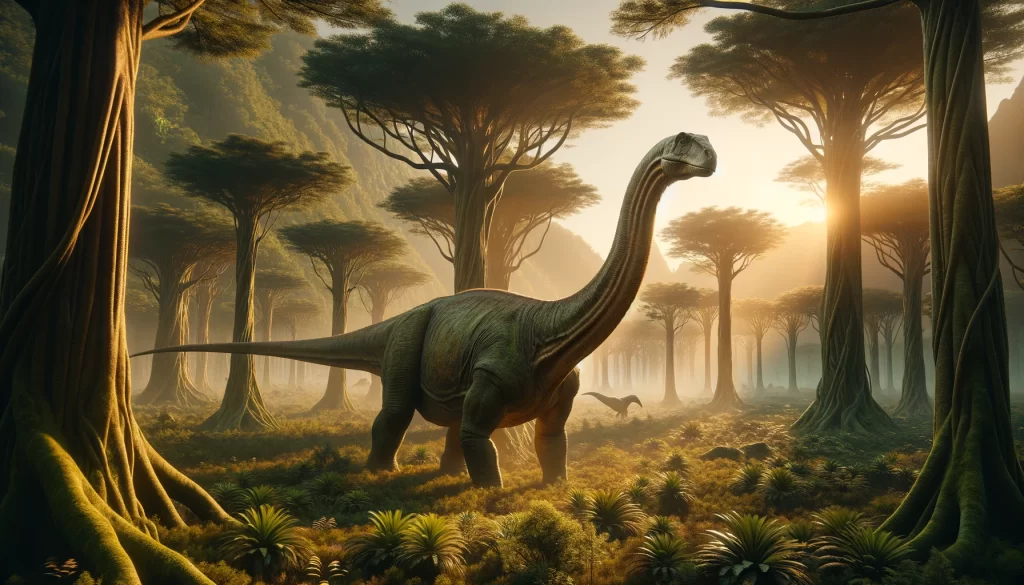
Brachiosaurus: The Gentle Giants of the Jurassic Era
The Brachiosaurus, a remarkable sauropod dinosaur, roamed the earth during the Jurassic period. This species stands out due to its incredible size, reaching lengths of 26 meters, heights between 12 to 16 meters, and weighing approximately 30 tons. As the tallest dinosaurs with complete skeletons discovered to date, Brachiosauruses also rank among the largest and heaviest creatures to have ever walked the planet. Their distinctive long forelimbs are the reason behind their name “Brachiosaurus,” which highlights their unique physical feature. Despite having a relatively small head, suggesting limited intelligence, a notable characteristic is the mound-like protrusion atop their head, serving as their snout. The extensive neck of the Brachiosaurus was a vital adaptation, enabling it to feed on high treetop leaves inaccessible to other dinosaurs, thus fulfilling its substantial dietary needs. Known for their mild disposition, Brachiosauruses were social creatures that preferred living in herds. This communal lifestyle was essential for meeting their significant feeding requirements, often leading them to migrate together. Their movements had profound impacts on their environment, causing the ground to tremble and smoke to billow, prompting smaller animals to flee in their wake. The legacy of the Brachiosaurus as gentle yet formidable giants of the Jurassic era continues to fascinate scientists and enthusiasts alike.
2. Mamenchisaurus
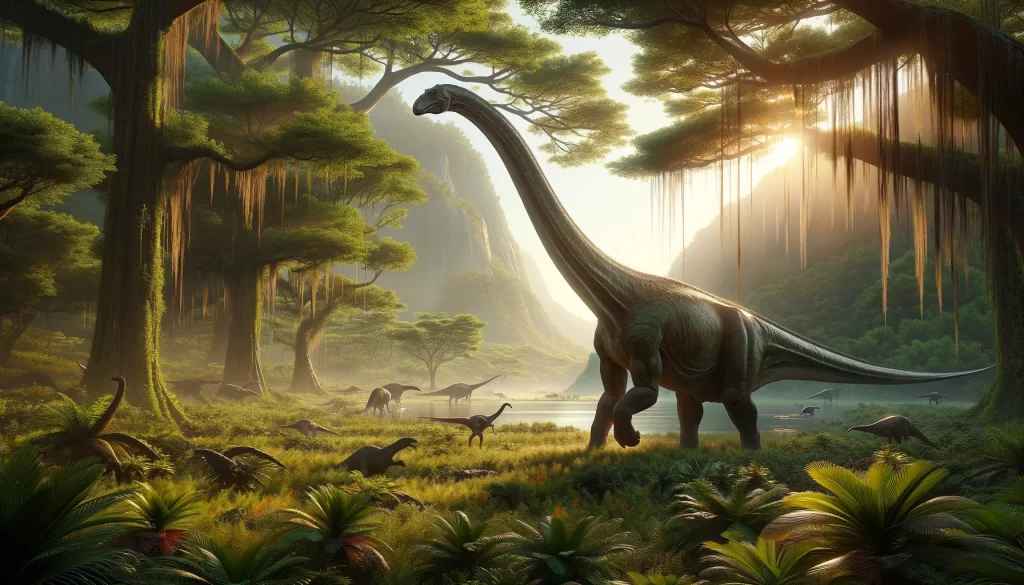
Mamenchisaurus: The Long-Necked Marvel of Chinese Dinosaurs
The Mamenchisaurus, a fascinating species from the late Jurassic period, reached an impressive length of 22 meters from its head to the tail tip, stood 7 meters tall, and weighed in at a hefty 55 tons during its lifetime. Its neck alone spanned 9 meters, three times longer than that of a giraffe, despite giraffes having only 7 cervical vertebrae compared to the Mamenchisaurus’s 19. This dinosaur’s neck was not only remarkable in length but also featured cervical ribs, some extending up to 3 meters, contributing to the neck’s strength but making it cumbersome to turn.
With a small skull, thin rod-shaped teeth, and a long neck atop a large and bulky spine, the Mamenchisaurus had a distinct appearance. Its limb joints were rough, indicating a massive and sturdy structure. The Hechuan Mamenchisaurus, discovered in Sichuan in 1957, is a testament to this species’ grandeur, measuring 22 meters in length and weighing nearly 40 tons. It had a small head and an incredibly elongated neck, resembling a crane in its stretch.
Mamenchisaurus spent most of its time in lakes and swamps, leveraging the water to support its immense body. It rested and laid eggs on solid, sandy grounds, feeding primarily on succulent aquatic plants. This dinosaur thrived 140 million years ago, only to become extinct by the end of the Cretaceous period.
In an era when China’s theropod dinosaurs might seem overshadowed, the Mamenchisaurus stands tall as a monumental figure, proudly representing the might and prestige of Chinese dinosaurs. It not only holds a place of honor among the giants of the past but also signifies a significant achievement in Chinese paleontology, embodying the pride of a nation’s ancient biological heritage.
3. Diplodocus
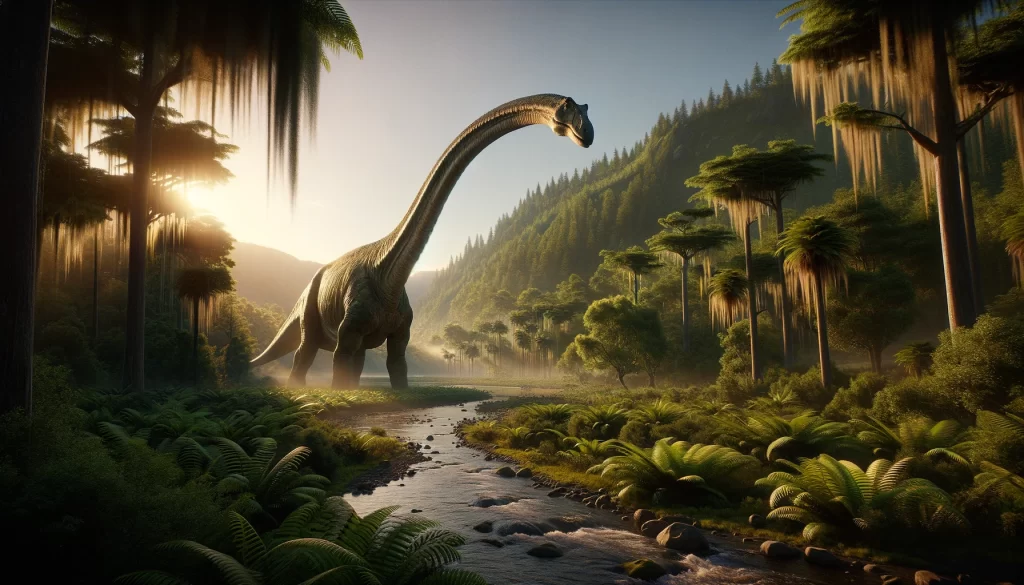
Diplodocus: The Iconic Long-Necked Giant of the Jurassic Period
The Diplodocus stands out as one of the most recognizable dinosaurs, thanks to its immense size, elongated neck and tail, and robust limbs. This dinosaur surpasses both the Apatosaurus and Brachiosaurus in length, but its distinctive long head and tail, coupled with a short torso and a slender build, mean the Diplodocus is not as heavy as its counterparts. Despite its extensive neck, the Diplodocus possesses a limited number of sturdy cervical vertebrae, preventing the neck from bending as freely as that of a plesiosaur. A common trait among the Diplodocus, Brachiosaurus, and Brontosaurus is the location of their nostrils at the top of their heads.
Spanning a length of 27 meters, the Diplodocus is characterized by its lightweight skeleton, which contributes to its thin physique, tipping the scales at just around a dozen tons. This weight is considerably less than that of the Apatosaurus and Brachiosaurus. The Diplodocus’s teeth are confined to the front of its mouth and are exceptionally small, limiting its diet to tender, succulent plants. With its diminutive head, the Diplodocus is not considered to have been highly intelligent. As a herbivore, this dinosaur ingested food without chewing, directly swallowing leaves to sustain itself. Despite its size, the Diplodocus was preyed upon by some of the larger carnivorous dinosaurs of its time.
4. Apatosaurus
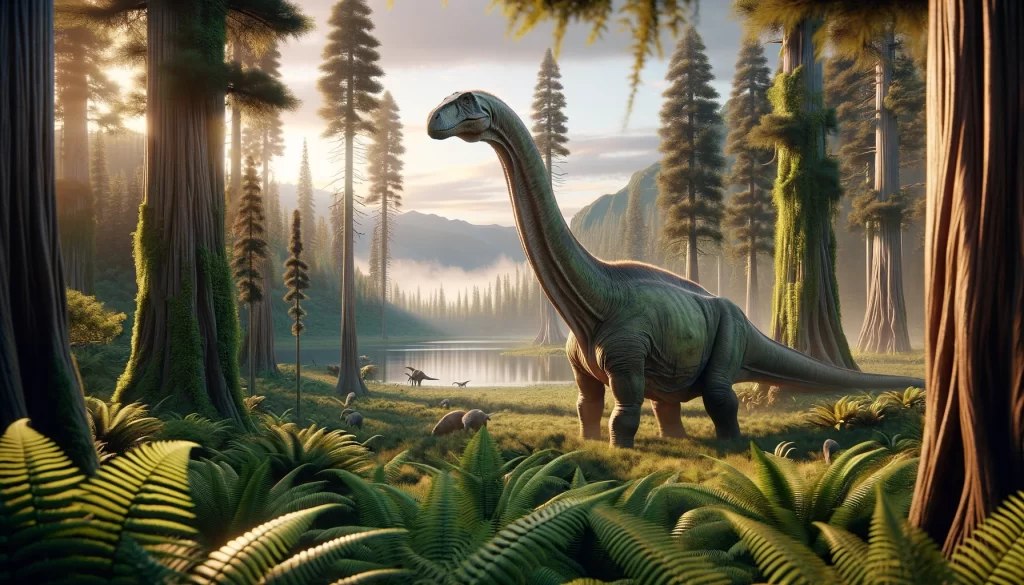
Apatosaurus: The Gentle Giants of the Jurassic Era
The Apatosaurus, belonging to the Diplodocidae family, roamed our planet approximately 150 million years ago during the Jurassic period. These colossal beings are among the largest land creatures to have ever existed, with some weighing as much as 20 tons. Recent discoveries of dinosaur thigh bones in Argentina suggest that they stood 4-5.5 meters tall and measured about 23 meters in length. The most distinctive features of the Apatosaurus include its thick, elongated neck and a slender, lengthy tail.
While the tails of many dinosaurs served purposes of attack and defense, studies indicate that the Apatosaurus’s tail, although once functional in such capacities, underwent a degree of degeneration due to environmental influences. This adaptation resulted in a more slender tail, diminishing its role in aggressive behavior. The neck of the Apatosaurus extends about 6 meters, surpassing the length of its body, with a tail stretching approximately 9 meters and a rump height of around 4.5 meters. Interestingly, the posterior half of its body is elevated above the shoulders, giving it a majestic appearance when it stands on its heels, akin to a towering cloud.
Speculation abounds that the Apatosaurus might have slept standing up and lived in herds, traversing plains and forests. These social giants likely utilized their immense size and collective strength to fend off predators. Once entangled in a taxonomic mix-up with the Brontosaurus, it is now clarified that the Apatosaurus and Brontosaurus represent two distinct species, each with its own unique place in the prehistoric landscape.
5. Brontosaurus
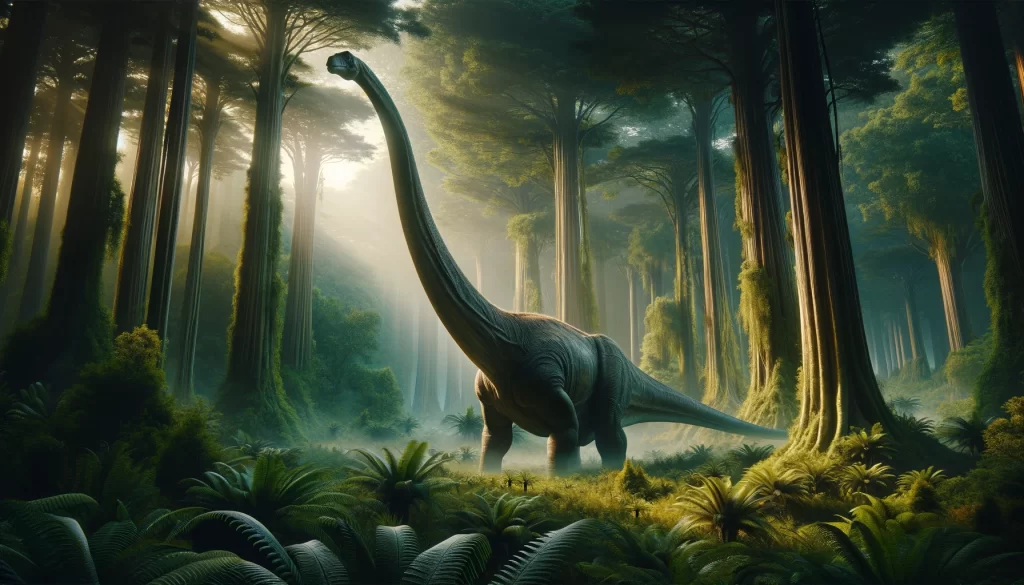
Brontosaurus: The Distinctive Giant of the Jurassic Period
The Brontosaurus, once considered the same as the Apatosaurus, belongs to the Diplodocidae family of sauropods that thrived approximately 150 million years ago. Measuring nearly 20 meters in length and tipping the scales at over 20 tons, the Brontosaurus is somewhat smaller than its close kin, the Apatosaurus, which could weigh between 50-55 tons. However, the average body mass of both dinosaurs is generally in the range of 10-15 tons, showcasing their colossal nature. Characterized by its elongated neck and whip-like tail, the Brontosaurus boasts a relatively small head in comparison to its body, along with spoon-shaped teeth, indicating its herbivorous diet.
The forelimbs of the Brontosaurus are slightly shorter than its hind legs, a feature that distinguishes it within the sauropod lineage. Its cervical vertebrae are shorter and more robust than those of the Diplodocus, and its leg bones are stronger and longer, suggesting a sturdier build compared to the Diplodocus. As it moved, its tail would typically not touch the ground, adding to its unique locomotion.
Furthermore, the Brontosaurus is equipped with a large claw on each of its forelimbs and claws on the first three toes of its hind limbs, enhancing its physical profile. This dinosaur, alongside its “sister” species, the Diplodocus, marks a different evolutionary path among sauropods. Not only did they feature long necks, but their tails were also extended, tapering to whip-like ends, an adaptation that may have had various functions, including defense.
As advanced sauropod dinosaurs, the Brontosaurus showcases significant developments in the structure of its vertebrae, including pit structures and internal holes within the vertebral body. These features represent adaptive changes aimed at supporting terrestrial life by reducing body weight, allowing these majestic creatures to thrive as giants of their time. The Brontosaurus stands out as a testament to the diversity and complexity of dinosaur evolution, offering insights into the life of Jurassic giants.
6. Omeisaurus
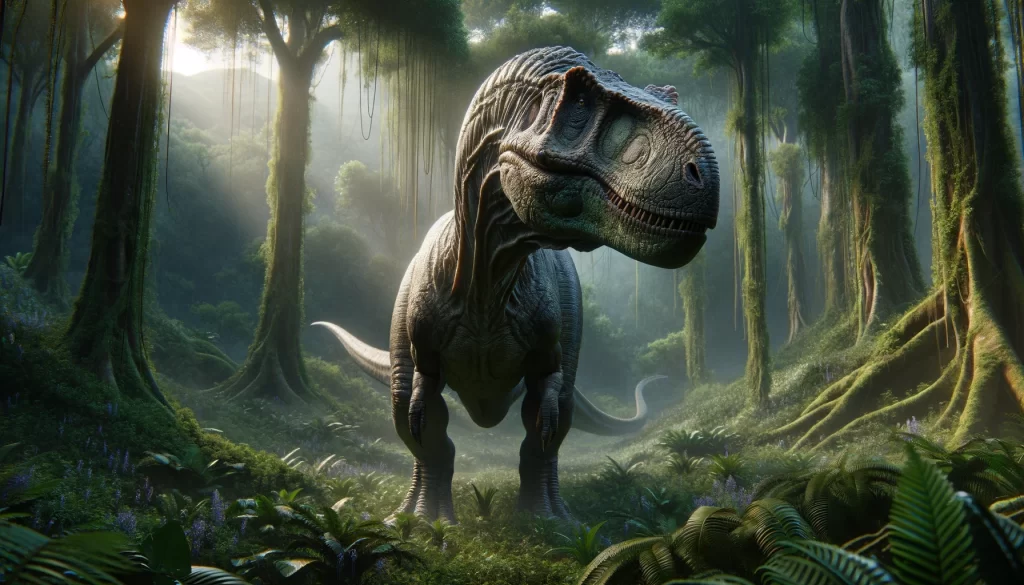
The Emeisaurus, a herbivorous entity, stands out within the diverse family of large sauropod dinosaurs. Exhibiting significant variation in size among its species, the body length of an Emeisaurus ranges from 10 to 20 meters, its height from 4 to 7 meters, and its weight approximates between 10 to 15 tons. This dinosaur is characterized by a notably large head, with the skull’s height surpassing half of its length, a trait not commonly observed in its sauropodomorph counterparts.
Boasting a typical sauropod physique, the Emeisaurus had a bulky body supported by a long neck and featured a wedge-shaped head. However, setting it apart from many of its sauropod relatives, the Emeisaurus displayed its nostrils at the front of its nose, diverging from the more common placement atop the head. The dinosaur’s anatomy was further distinguished by longer hind legs, making the highest point of its back reside at the buttocks, presenting a unique profile among its kind.
The Emeisaurus had a particularly elongated neck, supported by 17 cervical vertebrae, a number surpassing the average found in sauropods. This structural composition contributed to its exceptionally lengthy neck, with the longest cervical vertebra being thrice the size of the longest dorsal vertebra and exceeding the tail’s length by more than 1.5 times. The forelimbs of the Emeisaurus were short yet robust, equipped with claws on the first finger, and its hind limbs bore claws on the first, second, and third toes, indicating a strong physical framework.
Its teeth were large, featuring serrations at the front, a definitive indicator of its herbivorous diet. During its era, the Emeisaurus was among the most prevalent sauropods in China, favoring a gregarious lifestyle. These dinosaurs commonly established their habitats on the peripheries of inland lakes, showcasing their adaptability to their environmental surroundings. The Emeisaurus remains a significant figure in the understanding of prehistoric life in China, providing insights into the diversity and evolutionary nuances of the sauropod dinosaurs.
7. Shunosaurus
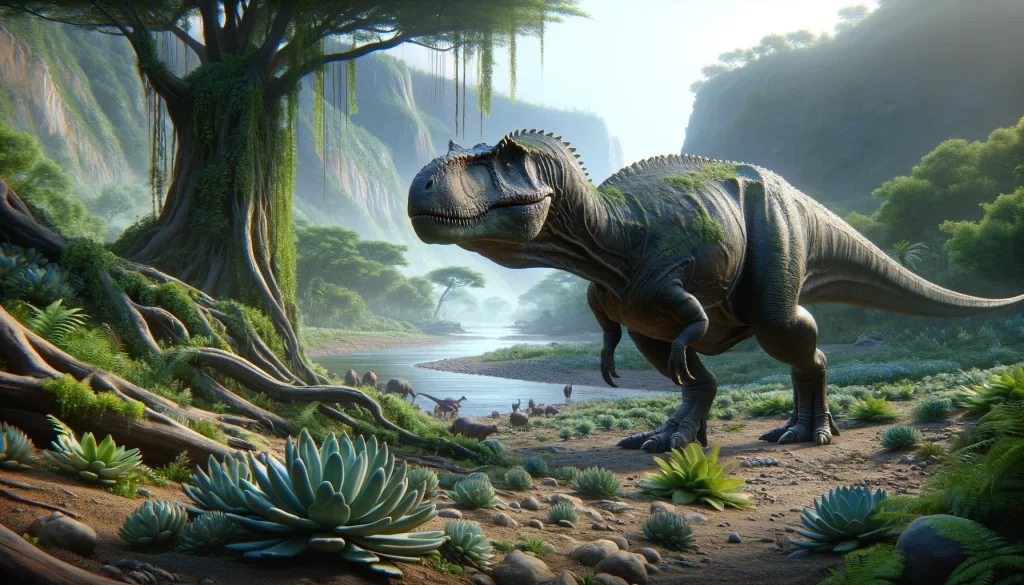
Discovered in Sichuan Province, the Shunosaurus draws its name from “Shu,” the region’s ancient appellation. This dinosaur is characterized by its cumbersome gait, moving on all fours, and distinguished by the notable tail hammer, serving as its primary defensive mechanism. The Shunosaurus predominantly inhabited areas adjacent to rivers or lakes, necessitated by its dietary preference for tender and succulent plants or the low-hanging branches and leaves of trees. Its teeth, leaf-like and lacking serrated edges, were adapted for this specific diet.
Measuring approximately 10 meters in length, the Shunosaurus is comparable in size to an adult female elephant. Among sauropods, it featured a relatively short neck, setting it apart from its long-necked relatives. With a short and deep skull, the nostrils of the Shunosaurus were positioned on the lower part of the muzzle, and its spoon-shaped teeth were notably robust. While sauropods are recognized as the largest land animals to have ever existed, the Shunosaurus represents a more primitive form within this dinosaur group, not yet exhibiting the massive body size that later sauropods would evolve.
The Shunosaurus was of medium size and had a shorter neck compared to other sauropods, making it an anomaly in the sauropod family. Its movements were slow, and it displayed a preference for communal living, often being found in groups alongside other species such as the whale dragons. The Shunosaurus boasted a unique self-defense mechanism: a bony tail hammer located at its tail’s end. Covered in flesh during its lifetime, this tail hammer resembled the size of a children’s football, attached to a thick tail that extended over 4 meters. This formidable “war hammer” could swing with enough force to potentially deter predatory animals, highlighting the Shunosaurus’s unique adaptations for survival in its ancient Sichuan habitat.
8. Daxiatitan
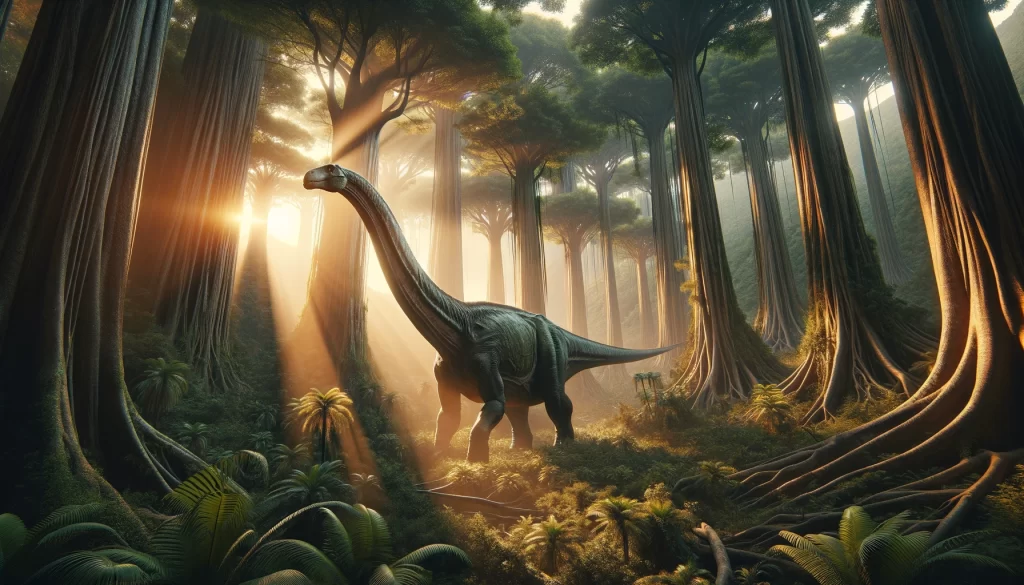
Daxiatitan: Unveiling the Giant of the Early Cretaceous Period
The Daxiatitan, a remarkable genus within the sauropoda titanosaurs, hails from the rich fossil beds of the Lanzhou Basin in Gansu Province, China, believed to have roamed the earth in the early Cretaceous period. The discovery of its cervical vertebrae and femurs has provided significant insights into its anatomy. With a staggering body length of 30 meters, the Daxiatitan ranks among the longest dinosaurs ever discovered in China. It is estimated to have possessed around 19 cervical vertebrae, contributing to a neck length of approximately 12.5 meters. The sheer height of its neck alone reached 8.7 meters, and it boasted a weight exceeding 70 tons during its lifetime.
As a herbivorous species, the Daxiatitan adapted to a life predominantly within the jungle environments. Its substantial energy needs, driven by the vast size of its body, necessitated constant foraging. Thus, the Daxiatitan would have spent much of its time wandering through the jungle, in search of the abundant food resources needed to sustain its enormous physique. This gentle giant of the early Cretaceous underscores the diverse and magnificent array of sauropods that once thrived on our planet, offering a window into the past ecosystems of what is now China.
9. Paralititan
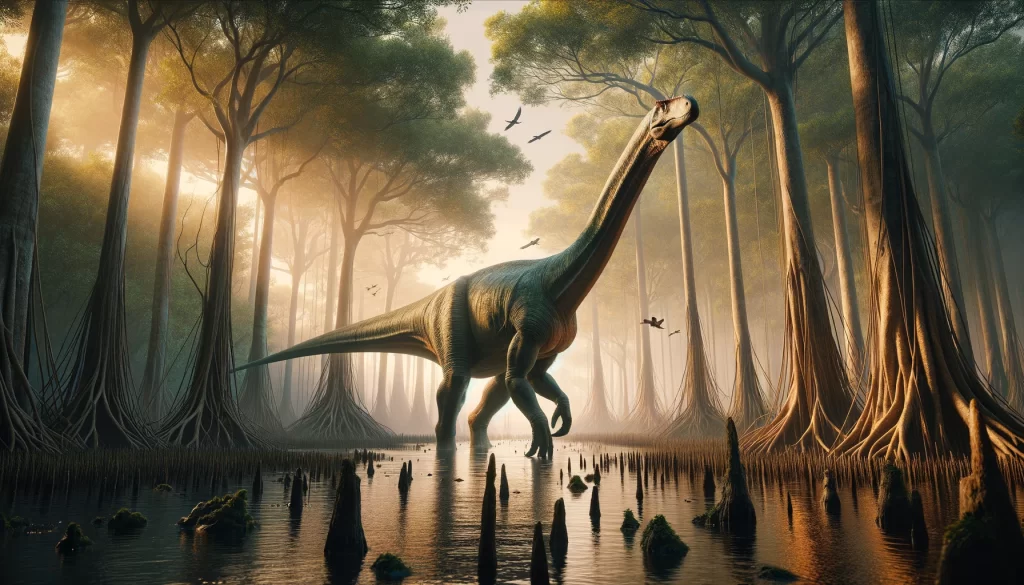
Paralititan: The Mangrove Dwelling Titanosaur of Ancient Times
The elusive Paralititan remains somewhat of a mystery within the paleontological community due to the sparse fossil record available. Despite this, the fragments unearthed suggest that the Paralititan ranks among the largest dinosaurs to have ever roamed the Earth, with weight estimates ranging from 60 to 80 metric tons. Its considerable size is further evidenced by an overall length spanning between 27 and 30 meters, inclusive of its neck, tail, and the central body portion. Sharing characteristics with other titanosaurs, the Paralititan is thought to have had a wide stance and potentially bore defensive bony protrusions on its body, aligning with its lineage’s known physical traits.
The Paralititan’s anatomy featured a small head and comparatively short legs, which likely made its movements rather cumbersome. This giant was not a predator but a herbivore, feeding on the vegetation of its habitat. Intriguingly, it dwelled not in arid lands but along the coastlines, an area that underwent transformations with the tidal cycles—sea at high tide and land at low tide, with the prevalent salty water conditions. Such an environment is inhospitable to most terrestrial plants, yet it is conducive to the growth of mangroves, which thrive in salty coastal waters.
The climate of the time, marked by its warmth, was ideal for rapid tree growth, providing ample sustenance for the Paralititan. This setting establishes the Paralititan as the first dinosaur confirmed to have lived within the unique ecological niche of mangroves. This adaptation to a mangrove environment underscores the diverse habitats in which dinosaurs existed and the Paralititan’s special place in the prehistoric world as a testament to the evolutionary versatility of these ancient giants.
10. Argentinosaurus
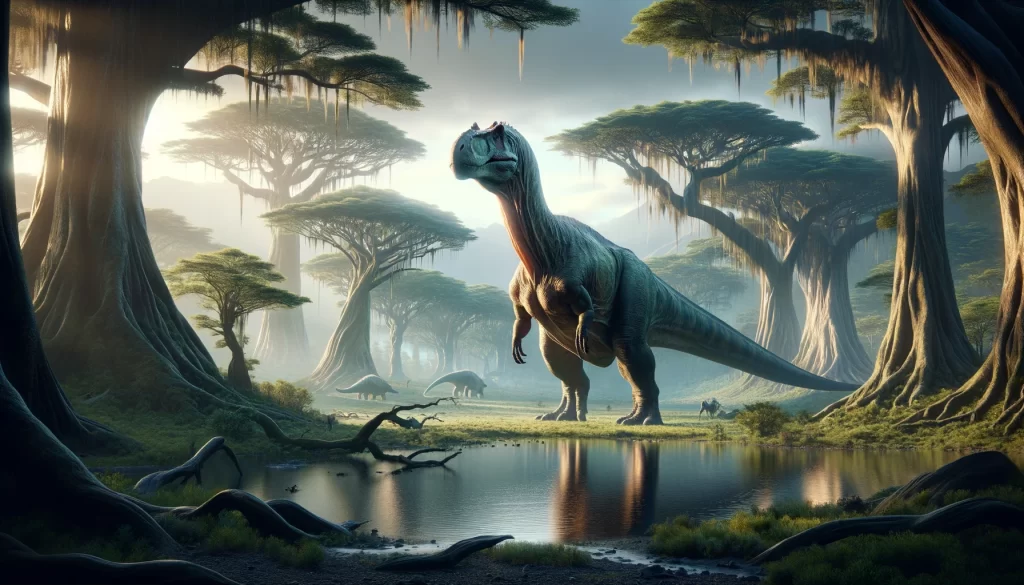
Argentinosaurus: The Colossal Titan of the Cretaceous Period
The Argentinosaurus stands as one of the most monumental animals to have ever graced the Earth, with an imposing height of 12 meters and a staggering length of 42 meters. In the annals of modern paleontological discoveries, only Amphicoelias fragillimus surpasses it in length. While some dinosaurs matched the Argentinosaurus in length and others in height, none could rival its astonishing weight. The Argentinosaurus might have tipped the scales at 94 tons, equivalent to the combined mass of 20 elephants, making it the heaviest dinosaur ever discovered.
Due to the incomplete nature of its fossilized remains, with only a partial skeleton found to date, the precise dimensions of the Argentinosaurus remain a subject of scientific speculation. Nonetheless, the discovered spine fragments alone, measuring 1.5 meters in height and 1.1 meters in width, provide a glimpse into the sheer size of this prehistoric giant. The habitat of the Argentinosaurus, characterized by lakeside regions flanked by dense forests, offered an ideal setting for this and many other large sauropods. These areas, rich in water and food sources, supported the survival of these gigantic creatures, allowing them to thrive in the lush, resource-abundant environments of their time.
The Argentinosaurus’s remarkable size and weight, combined with its unique habitat, underscore its significance in the study of prehistoric life. As scientists continue to uncover and analyze more about this colossal dinosaur, the Argentinosaurus remains a symbol of the incredible biodiversity and ecological complexity of the Cretaceous period, captivating the imagination of both the scientific community and the public alike.

